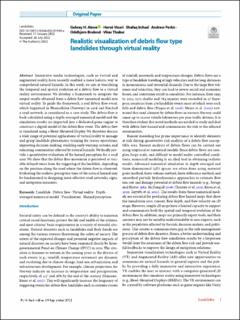| dc.contributor.author | Alene, Gebray Habtu | |
| dc.contributor.author | Vicari, Hervé | |
| dc.contributor.author | Irshad, Shafaq | |
| dc.contributor.author | Perkis, Andrew | |
| dc.contributor.author | Bruland, Oddbjørn | |
| dc.contributor.author | Thakur, Vikas Kumar Singh | |
| dc.date.accessioned | 2023-01-06T09:33:32Z | |
| dc.date.available | 2023-01-06T09:33:32Z | |
| dc.date.created | 2022-10-03T10:13:11Z | |
| dc.date.issued | 2022 | |
| dc.identifier.citation | Landslides. Journal of the International Consortium on Landslides. 2022, . | en_US |
| dc.identifier.issn | 1612-510X | |
| dc.identifier.uri | https://hdl.handle.net/11250/3041462 | |
| dc.description.abstract | Immersive media technologies, such as virtual and augmented reality, have recently enabled a more holistic way to comprehend natural hazards. In this work, we aim at visualizing the temporal and spatial evolution of a debris flow in a virtual reality environment. We develop a framework to integrate the output results obtained from a debris flow numerical model into virtual reality. To guide the framework, a real debris flow event, which happened in Hunnedalen (Norway) in 2016 and blocked a road network, is considered as a case study. The debris flow is back-calculated using a depth-averaged numerical model and the simulation results are imported into a dedicated game engine to construct a digital model of the debris flow event. The debris flow is visualized using a Head-Mounted Display. We therefore discuss a wide range of potential applications of virtual reality to manage and grasp landslide phenomena: training for rescue operations; improving decision-making; studying early warning systems, and educating communities affected by natural hazards. We finally provide a quantitative evaluation of the hazard perception for a road user. We show that the debris flow movement is perceived at variable delayed times from the triggering of the landslide, depending on the position along the road where the debris flow is observed. Evaluating the realistic perception time of the natural hazard may be fundamental to designing more effective road networks, signs, and mitigation measures. | en_US |
| dc.language.iso | eng | en_US |
| dc.publisher | Springer | en_US |
| dc.rights | Navngivelse 4.0 Internasjonal | * |
| dc.rights.uri | http://creativecommons.org/licenses/by/4.0/deed.no | * |
| dc.title | Realistic visualization of debris flow type landslides through virtual reality | en_US |
| dc.title.alternative | Realistic visualization of debris flow type landslides through virtual reality | en_US |
| dc.type | Peer reviewed | en_US |
| dc.type | Journal article | en_US |
| dc.description.version | publishedVersion | en_US |
| dc.source.pagenumber | 11 | en_US |
| dc.source.journal | Landslides. Journal of the International Consortium on Landslides | en_US |
| dc.identifier.doi | 10.1007/s10346-022-01948-x | |
| dc.identifier.cristin | 2057682 | |
| cristin.ispublished | true | |
| cristin.fulltext | original | |
| cristin.qualitycode | 1 | |

